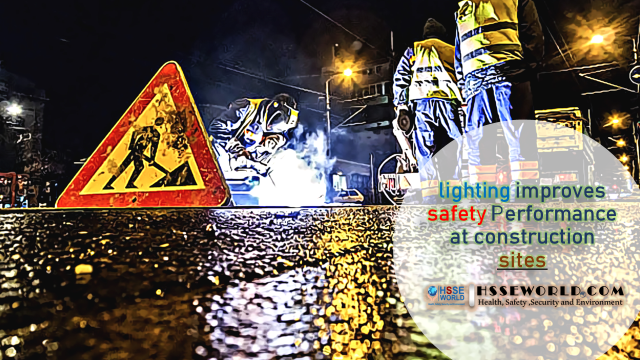When working at a construction site, safety is one of the most important elements. Lighting plays a role in overall safety, especially at dusk or night when visibility is greatly reduced. Builders have important and dangerous jobs as they develop the essential infrastructure society relies on. Nearly 20 percent of fatalities at work occur on construction sites. The number of injuries increases during nighttime building projects.
Temporary lighting increases construction site safety and security while reducing the risk of injuries and fatalities. By reading the following article you will be familiar with:
- How bad are the fatalities and injuries in construction?
- The Importance of Efficient Temporary Lighting
- Lighting Standards for Construction Sites
- Types of Lighting for Construction Sites
- Safety tips before working at night
Also Read: Photo of the day: 10 Scaffold Safety Essentials

How bad are the fatalities and injuries in construction?
The industry has seen a huge drop in worker deaths from an average of 38 per day in 1970 to about 15 per day in 2019 as reported by the Occupational Safety and Health Administration. Unfortunately, OSHA says the construction industry still accounts for 20% of all worker fatalities in a year.
OSHA reports that 60% of the fatalities are due to the “Fatal Four” construction hazards. These include the following:
( Read more: Photo of the day: How to Avoid the Fatal Four )
Construction sites that take steps to eliminate these four will save many lives. It’s not just the fatalities that are a concern for construction companies. Everyday injuries occur at a much higher rate. These numbers are better than they were in the 1970s, but there is room for improvement as 3 out of 100 workers had an injury in 2019. This covers only the reported injuries.
A notable 25% of construction workers say they won’t report their injuries according to a survey from the Center for Construction Research and Training. Either they thought the injury was minor or that it was the nature of the job and they should not complain.
Also Read: Forklift Operator’s Daily Checklist and Safety Tips
The National Safety Council reports that occupations in construction are one of the top five industries with the largest number of injuries. It’s challenging to make sure the construction project stays on schedule between the shortage of qualified construction workers and finding replacements. All that said, it’s critical to look for ways to reduce construction site deaths and injuries.
You can do many things to improve safety and lower injuries. Lighting is one of them. However, construction site lighting is a science that requires strategy and planning. There are factors to consider such as what kind of lighting, how much lighting, and where to place the lights.
Lighting Standards for Construction Sites
OSHA standard 29 CFR 1926.56 contains the minimum requirements on lighting for construction sites as it states the following.
“Construction areas, ramps, runways, corridors, offices, shops, and storage areas shall be lighted to not less than the minimum illumination intensities listed in Table D-3 while any work is in progress.”
OSHA also considers industrial lighting standards and recommendations from other agencies such as American National Standards Institute (ANSI). The original practice for industrial lighting from American National Standard A11.1-1965, R1970 contains recommended values of illumination.
A letter from OSHA‘s Directorate of Compliance Programs states this standard is “a nationally-recognized consensus standard cited by reference under paragraph 1910.261 of Part 1910-Safety and Health Regulations For General Industry and under paragraph 1926.56 of Part 1926-Safety and Health Regulations For Construction. This ANS standard was developed with the active collaboration of the Illuminating Engineering Society (IES), now identified as the Illuminating Engineering Society of North America (IESNA). OSHA recommends that employers use this standard as guidelines to determine sufficient lighting required to provide for the safety and health of employees in workplaces.”
OSHA standard 1926.56(a) only provides minimum illumination requirements for a construction site. Your construction site might also have more stringent occupational safety requirements for exterior lighting. So, check the regulations for your state.
Types of Lighting for Construction Sites
Before business owners develop a temporary lighting plan, they should evaluate the various types of construction lights. Assessing the different options can help individuals purchase the most effective supplies to support on-site safety. There are four lighting choices available to construction workers.
- Balloon Lights. Builders can utilize balloon lights to access portable, glare-free illumination. The device also reduces shadows, increasing construction professionals’ visibility on-site. Balloon lights provide 360 degrees of lighting, reducing injuries on the job. The temporary lights also run on electricity, decreasing emissions and improving local air quality. Individuals can set up the devices to stand alone or mount them to equipment. They may also add light-emitting diode (LED) bulbs to the lamp, further improving its illumination capabilities and sustainability. LED bulbs are more energy efficient than incandescent lights, helping construction professionals reduce emissions and save money. They also last about 10 times longer, producing less waste over time. When builders improve the sustainability of a construction site, they decrease one’s risk of inhaling air pollutants and experiencing adverse lung health effects.
- Equipment-Mounted Lights. Equipment-mounted lights also enhance job site visibility, reducing the risk of injury. The device increases illumination from heavy machines. Many pieces of equipment have small headlights that fail to brighten an entire construction path. Construction professionals can also use mounted lights to provide direct streams of illumination throughout a job site. They may attach the devices to stationary devices, enhancing ground-level brightness.
- Portable Light Towers. Individuals may also utilize portable light towers to illuminate construction sites. Multiple lamps make up the tower, attaching to a single mast. Conventional generators power the light source, running on gas or diesel. Some manufacturers also make battery-powered versions. Builders can access these alternative models to decrease noise pollution and improve local air quality.
- Warning Lights and Temporary Roadway Lighting. Another way to improve on-site safety is setting up warning and roadway lights. Flashing bulbs can alert oncoming traffic of construction sites, reducing collisions. Builders may also add warning lights to heavy machines to increase workers’ awareness of moving devices. Adding temporary light poles on roads with construction projects can additionally enhance illumination.
Factors to Consider and Safety Tips
- Planning On-Site Lighting Arrangements
Before construction professionals set up their lighting system, they should develop a strategic plan to improve efficiency and minimize interference. During the planning phase, builders may consider a system’s effects on surrounding wildlife. They can also prevent illumination interference by shifting shadow-producing materials on the site. Workers may also decrease job site injuries by utilizing other visibility-enhancement methods. They may wear reflective garments and headlamps, helping other workers see them. Builders can also wear anti-glare glasses, protecting their eyes and improving visibility.
- Choosing the Right Type of Lighting
Many people aren’t aware that brighter lighting is not always better. Few know how the importance of color and hue makes a difference in visibility. It’s critical to avoid using lighting that causes glare problems and hurts workers’ eyes. That’s why it’s recommended that you work with a security expert who has experience in lighting. They will help you figure out what types of lights you need, how many lights you need, and where to place them.
Don’t forget to add lighting in other areas such as the parking lot and the walkway between the parking and the construction site.
Lighting does more than help worker safety. It also boosts security. A Propmodo story says that the most common cause of theft on construction sites is due to “security negligence.” This means they have insufficient lighting and poor construction site security.
In addition to lighting, you can enhance construction site security with remote video surveillance that includes video analytics and trained monitoring operators. The operators are not on the construction site. They monitor the site from another location.
A lot happens on a construction site. It’s hard to watch over it all with the many security and safety challenges. Implementing effective lighting and video surveillance can help protect your workers and your assets. The security camera system records and saves everything.
Also Read: Taking Action Against Acts of Workplace Violence
- Safety Tips
Working at night poses a serious safety risk for highway & construction workers. Those who work at night are at a higher risk for injury because of:
- reduced visibility for motorists
- reduced visibility for workers
- lack of communication between shifts
- increased number of impaired or drowsy drivers
- sleep deprivation for workers
Always use special safety precautions when working at night. Most importantly, you must increase your visibility to passing motorists and know your surroundings.
- wear high visibility clothing
- wear flashing lights on your body and clothing
- place high visibility tape on equipment
- Use proper work area lighting
- know the vehicle and equipment paths
- know your assigned work area(s)
- know the safe routes to and from work
- on foot, watch out for equipment
- on equipment, watch out for workers
- always provide clear signage/traffic cones
Also Read: E-Books: Fire Safety Management Handbook 3rd edition
Please visit our Safety Resources SAFETY BAG to have many Safety Resources





